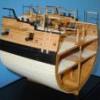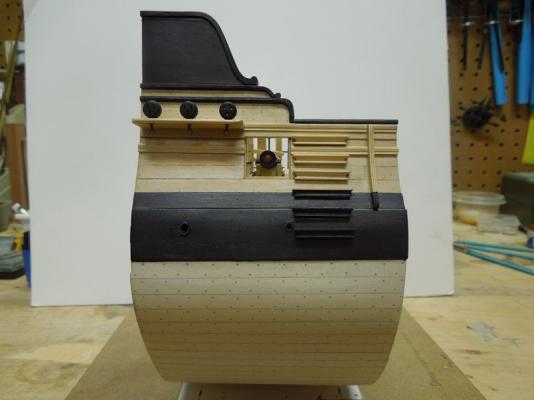-
Posts
2,449 -
Joined
-
Last visited
Content Type
Profiles
Forums
Gallery
Events
Everything posted by dvm27
-
Lovely planking job, Ed. Sort of hard to know where to stop on this demonstration model. I wonder if you were tempted to complete the planking on the port side? As difficult as planking the stern curved area on your model was I'm wondering what sort of Herculean effort this task might have taken on the real ship!
- 191 replies
-
- young america
- clipper
-
(and 1 more)
Tagged with:
-
Wonderful metal and wood work in this installment. What blackening agent did you use? The results are very uniform.
- 346 replies
-
- terror
- polar exploration
-
(and 2 more)
Tagged with:
-

ancre Le Fleuron 1729 by rekon54 - 1:24
dvm27 replied to rekon54's topic in - Build logs for subjects built 1501 - 1750
Beautiful work, Rekon. Just out of curiousity, what was the use of those two aft cabins? With those large knees there's not much room inside. -
"Missed it by that much" - Maxwell Smart Or maybe you Aussies never received "Get Smart" from the classic age of US television.
- 99 replies
-
I use Fiebings leather dye. It does a beautiful job but you need to be careful when applying as it penetrates very well. I usually stain pieces like wales off the model and touch them up after securing them in place. Their brown dye is perfect for blocks. You may also achieve a very nice black color, especially on brass, using black automotive primer. Several light coats fill in small gaps and leaves a nice smooth finish.
- 255 replies
-
- granado
- bomb ketch
-
(and 2 more)
Tagged with:
-
I was never happy with turned ebony. Very difficult to keep crisp edges on the reinforcing rings resulting in small nicks and the incredible black mess. If you continue to have failed pieces you may wish to consider turning boxwood or pear. After dyeing them you can't tell the difference and your lungs are much happier.
- 255 replies
-
- granado
- bomb ketch
-
(and 2 more)
Tagged with:
-
Best of luck from a fellow three-time sufferer Patrick. Passing a kidney stone is much more painful than passing a kid (statement verified by women, I would never make such a claim). You should try to incorporate your kidney stone (they're surprisingly small) into Majellan to make a really personal model.
- 1,083 replies
-
Looks great, Mike. Personally, I find the fairing process the most satisfying part of the build as the smooth hull emerges amidst the sawdust. I start with 80 grit rubber cemented onto a variety of shaped sanding sticks.
- 967 replies
-
- hahn
- oliver cromwell
-
(and 1 more)
Tagged with:
-
The first two volumes of TFFM are a complete treatise on building a Swan class model. They are a step-by-step guide. They do not include the plans, which may be purchased from Admiralty Models. Volume Three is an photo companion to the first two books. Volume Four is the masting and rigging guide and it does complete masting and rigging illustrations for a Swan class model (or other sixth rate).
-
Perhaps I missed it in your log but what did you use for caulking between the deck planks? Black paper? The effect is excellent!
-
The tidiness of your workshop explains your meticulous attention to detail. If I were as organized as you I'd probably work at least 10% faster!
-
On my first model I used CA to secure the knots. Twenty years later I note these areas are discolored and appear very brittle. I would not be surprised if the CA'd areas fracture at some point in the near future. I now use matte medium (per Harold Hahn's technique) or dilute PVA. Both work very well.
-
For what it's worth I have the self centering chuck from Sherline and its worked very well for me. As long as the piece is secure in the chuck with a live center in tail stock you can easilyturn irregular pieces of stock material.
- 1,449 replies
-
Lovely planking, Mike. I see you're using spacers between the planks. I look forward to seeing how you caulk them.
-
Bravo, Mike. That's a very Chuck-looking transom and you can't do better than that!
- 452 replies
-
- cheerful
- Syren Ship Model Company
-
(and 1 more)
Tagged with:
-
Lovely work, Toni. Working out the setups on the mill is fun, isn't it? Takes much longer than the actual machining.
- 1,449 replies
-

Echo by Maury S - FINISHED - Cross-Section
dvm27 replied to Maury S's topic in - Build logs for subjects built 1751 - 1800
Very nice Maury. Leaving the "black strake" clear saves you from making a two toned entry step.- 324 replies
-

Gluing 101
dvm27 replied to CPT_D's topic in Building, Framing, Planking and plating a ships hull and deck
The simplest and most important tip that I learned from my mentor is to clean up every glued joint with water and a small paint brush immediately. It's very hard to scrape or remove glue once set. -

Echo by Maury S - FINISHED - Cross-Section
dvm27 replied to Maury S's topic in - Build logs for subjects built 1751 - 1800
I used the top and butt method of anchor stock planking. The combined two lower strakes of the main wale are 20" wide. I used 12" for the thickest part and 8" for the thinnest part. I used 20' for the length of the plank with a 14' and 6' section. Once you lay this out on paper the angles are set. It's very easy to cut these using the taper jig on the Byrnes table saw. If you are planning to paint or dye the wales you may wish to forgo this and just use plain strakes. As you'll see in the photo my meticulous top and butt joinery is not visible after sanding and staining. One last point - the "black" strake may be either blackened or not.- 324 replies
-
The hardest part of building a fully framed model (at least for me) is establishing a nice clean run of the gun port sills. Cumulative error makes it very difficult to add the mortises for the sills before raising the frames. I believe Toni (?) cut all hers after fully framing the model and drawing a nice shear line across the entire hull. However, it is a bit more difficult to cut the mortises when the frames are installed. Of course if you are planking the model it makes no difference as sills can be cut back or padded as needed to match the planking.
- 504 replies
-
- washington
- galley
-
(and 1 more)
Tagged with:
About us
Modelshipworld - Advancing Ship Modeling through Research
SSL Secured
Your security is important for us so this Website is SSL-Secured
NRG Mailing Address
Nautical Research Guild
237 South Lincoln Street
Westmont IL, 60559-1917
Model Ship World ® and the MSW logo are Registered Trademarks, and belong to the Nautical Research Guild (United States Patent and Trademark Office: No. 6,929,264 & No. 6,929,274, registered Dec. 20, 2022)
Helpful Links
About the NRG
If you enjoy building ship models that are historically accurate as well as beautiful, then The Nautical Research Guild (NRG) is just right for you.
The Guild is a non-profit educational organization whose mission is to “Advance Ship Modeling Through Research”. We provide support to our members in their efforts to raise the quality of their model ships.
The Nautical Research Guild has published our world-renowned quarterly magazine, The Nautical Research Journal, since 1955. The pages of the Journal are full of articles by accomplished ship modelers who show you how they create those exquisite details on their models, and by maritime historians who show you the correct details to build. The Journal is available in both print and digital editions. Go to the NRG web site (www.thenrg.org) to download a complimentary digital copy of the Journal. The NRG also publishes plan sets, books and compilations of back issues of the Journal and the former Ships in Scale and Model Ship Builder magazines.



